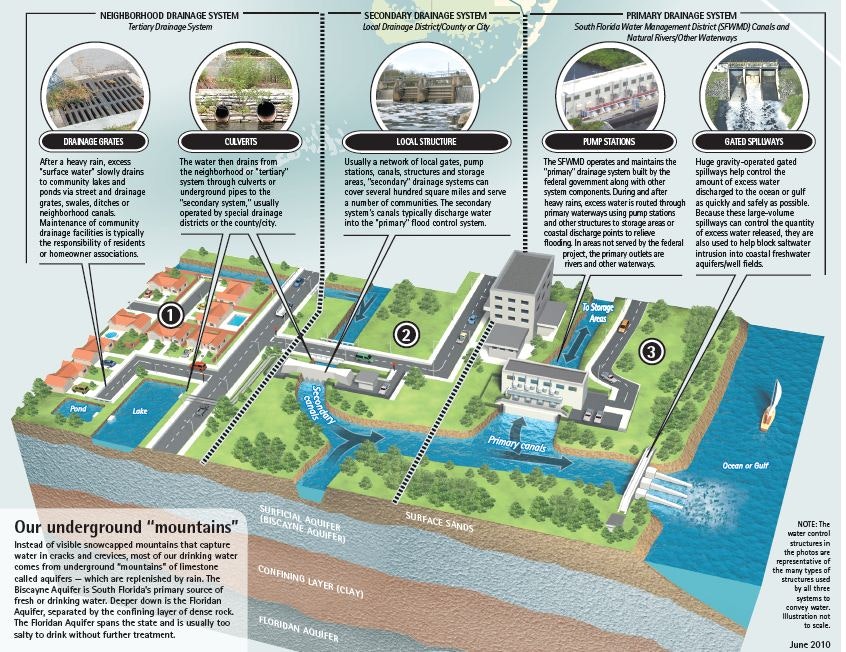Stormwater Information

Flood control in Florida is a shared responsibility that provides maximum benefit only when all components (primary, secondary and tertiary) are designed and constructed to work together and are maintained in proper working order. Florida is more complex than many states, where one entity usually provides local and regional drainage for the community. In Florida, some areas have no formal drainage systems and are prone to routine flooding; others may be covered by several organizations or governments providing varying service levels. Depending on conditions, water may have to be routed through several interconnected, though independent, conveyance systems –each of which must be properly maintained and functioning – to provide flood protection for south Florida neighborhoods.
So, what path does stormwater typically follow from your neighborhood to its final destination? Here's an example. Five inches of rain falls in 24 hours over an inland community. This rain follows a wet period, so groundwater levels are already high. According to most approved drainage designs, some water is temporarily stored in public recreational areas, yard swales and streets. Drainage swale areas are sloped to catch water and filter out pollutants as water is absorbed into the ground. Some yards direct water to the community drainage system as runoff, with very little water retained in the yard. The excess surface water slowly drains to community lakes or on-site ponds via street and yard drainage grates, swales, ditches or canals. Homeowner associations typically assume the maintenance and upkeep of community drainage facilities. Water then drains from the community or "tertiary" system through underground pipes to the "secondary" system, which is mainly operated by the Northern Palm Beach County Improvement District (Northern) in northeastern Palm Beach County. Cities and the County also maintain “secondary” systems, depending on the development plans for an area.
The "secondary" drainage system is usually a network of canals, structures, pumping stations and storage areas. These systems can cover several hundred square miles and serve many communities. In communities maintained by Northern, stormwater systems are gravity-fed or pumped using stormwater pump stations. Water moves through a series of lakes and canals via weirs (fixed structures), operable gates and pump stations. These systems sometimes move water through multiple communities, so the "downstream" effects must be considered when moving water from one area to another. The stormwater systems discharge into local canals managed by either Northern or other municipalities. Northern uses a telemetry system to monitor and remotely open and close gates and pumps. Weather conditions and water levels are monitored around the clock. Water levels in the secondary drainage system can be lowered to allow more water storage and minimize flooding. These systems discharge water into the "primary" flood control system as long as carrying capacity is available.
The South Florida Water Management District operates the "primary" drainage system. In anticipation of heavy rains, floodgates may be opened, and water levels might be lowered to accommodate direct rainfall and accept inflows from the "secondary" systems. During and after heavy rains, excess water is routed through all available "primary" waterways to regional storage areas or coastal discharge points to relieve flooding as quickly and safely as possible.
What can YOU do to help?
As a resident or business owner, you play a crucial role in flood control. Your actions can make a significant difference in your community's resilience to flooding. Here's what you can do:
- Make sure your neighborhood's drainage grates, ditches, and swales are clear of debris.
- Remove loose items, including yard debris, from your yard. Debris and litter can clog storm drains and cause flooding.
- Check your community retention pond or lake for obstructed pipes and contact the appropriate authority for removal (this could be your HOA/POA, city, county, or local drainage district).
- Find out who is responsible for drainage in your community. Visit SFWMD.gov/FloodControl. Note the service area status under the search results. Even if the location is within an agency’s jurisdiction, it may not be serviced.
As a homeowner or property owner association official, you are a key player in the flood control process. Your knowledge and actions can greatly contribute to your community's flood resilience. Here's what you can do:
- Familiarize yourself with your particular drainage system and how it fits into the overall South Florida drainage picture.
- Learn how the stormwater system works in your area and how to properly maintain the facilities under your responsibility.
- Understand your community's irrigation needs. Turn off your irrigation before the storm. Return to normal operating conditions after the storm. Remember, if the ground is saturated, you may not have to irrigate for quite some time after the storm.
Reporting the location and condition of any clogged or damaged facilities is a crucial step in flood control. By doing so, you are actively contributing to your community's flood resilience. Please make a note of important telephone numbers and keep them handy for quick reporting.
Note: If you would like a copy of any of the documents listed above, please call (561) 624-7830 or email office@npbcid.org and specify if you need it in a specific format for assistive technology. Users who need accessibility assistance can also contact us by phone through the Florida Relay Service at 711 for TTY/Voice communication or 800-955-8771 if you are using TTY equipment.
